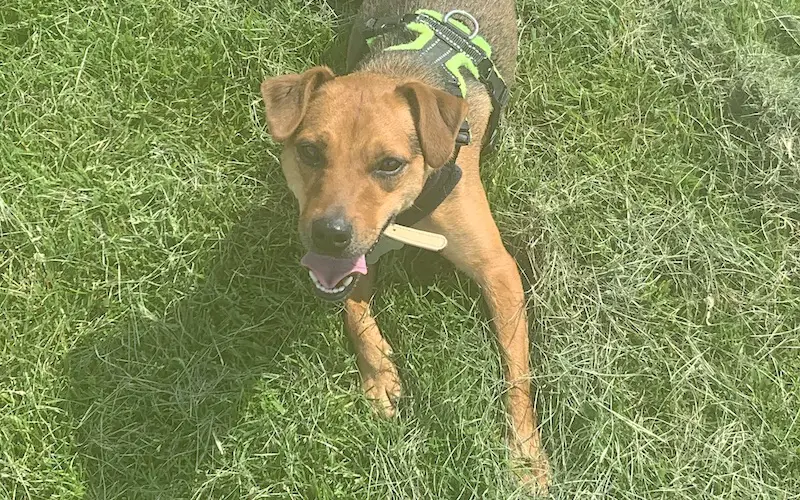patterdaleterriers.co.uk is a participant in the Amazon Services LLC Associates Program and other affiliate advertising programs designed to provide a means for us to earn fees by linking to Amazon.co.uk and affiliated sites. Affiliate links may be used on this page and in patterdaleterriers.co.uk articles, but they do not impact on the price that you pay and they do help me to get this information to you for free. Read my privacy policy for more information regarding affiliates.
Patterdale terrier puppies are a small and cute looking English dog breed known for their friendliness, being inquisitive, and for their eagerness to please, though are sometimes known for showing guarded behaviour. They make a fine choice for someone seeking a dog of relatively small size (typically between 12-15 inches tall and weighing 11 to 13 pounds). They are specifically bred for hunting, so they will have little reservation about pursuing animals like foxes and racoons, often to less than ideal results. Much like other terriers, patterdale terriers are lively, confident, and full of energy, so much so that an owner of one needs to be prepared to give their Patterdale puppy a lot of exercise to keep him from getting bored and destructive.
Getting A Patterdale Puppy
Getting a Patterdale puppy does not need to be a complicated process, but certain steps should be considered. The primary concern is how to come about acquiring the dog. The way to find a patterdale terrier for your home is to go to a breeder. This is an important choice to make. Unlike puppies from kennels, reputable breeders care and look after the puppy’s mother during her pregnancy and after. The breeder will have a lot of good information about the parents, and be able to speak to their personalities, dispositions, and history.
Visiting a breeder is also a good chance to potentially meet the mother, as well as your prospective future pet, and perhaps even the father. The process of getting a puppy can be a long one however. To a litter of Patterdale terrier puppies just born, it is imperative to stay connected to their mother who will nurture them and take care of them. For at least the first 12 weeks of a patterdale puppy’s life, it is important that he or she remain in proximity of its mother, awaiting a maturity milestone where the ultimate separation won’t be as arduous for either canine.

Health Considerations
The breeder can also communicate information about the health of the Patterdale terrier puppies, so an owner knows what type of responsibility they are assuming. Some attributes to look for in a puppy involve both physiological and psychological assessments.
Patterdale puppies carry some significant concerns with their eyes, being vulnerable to developing glaucoma and cataracts. Make sure that the puppy has clear, bright eyes and uninfected ears is crucial to making sure that the puppy is healthy and will grow and develop accordingly.
There are a few things to know healthwise about these dogs as well after they are in your home. Maintaining good Patterdale terrier health is important for owners to understand. They will need injections as pups (plus annual boosters). You will also need to use a flea treatment and worm them regularly. Terriers can be prone to dew claw injury.
This breed can also develop issues with their knees as the puppy gets older. This is an issue most terrier breeds are susceptible to and is actually not as horribly painful as it sounds. The condition is called patellar luxation, and it is when the kneecap slips out of place. At that point the dog may kick its left to the side of the body to force the patella to pop back into place. Either way, it is an issue to consider bringing up to the dog’s vet.
Some Patterdale terrier puppies develop a liver disorder called portosystemic shunt (PSS), and it occurs when blood meant to go to the liver, ends up going around it, causing a lack of oxygen and nutrients the liver requires to function. It can be diagnosed with a blood test, so a regular liver panel is important to conduct at every annual visit.
You can read more about Patterdale Terrier health problems on our website.
Preparations
Before bringing your puppy home from the breeder, some preparatory work is in order. Think of it as puppy-proofing your home. Loose articles or clothing, shoes, and floor plants should be removed or stored in hard to reach places. Any clothes or towels should be secured in place, and anything a puppy could potentially enjoy chewing on should be wrapped. This includes legs of chairs as well as electrical wires.
It is important to obstruct access to any bodies of water including pools and ponds. These energetic puppies can slip through pretty small spaces, so it is important that their way to danger is impeded or blocked. All drawers should be closed and any potential hiding spots should be covered.
Everyone in the house should formally decide where the puppy will sleep, eat, and go to the toilet. A feeding schedule should be prepared and a decision is made about who and when the puppy will be played with. Remember, these pups have a lot of energy and they will need a lot of exercise. This breed will not be content with a couple of short walks, and if they are cooped up, they will find ways to entertain themselves at the expense of the owner’s often pricey possessions.
In the preparation process, young children should be warned to be calm with the dog, especially at first, as the puppy will only be getting used to its new surroundings. You may find this new puppy checklist helpful.
Bringing The Puppy Home
When the puppy is brought home, it’s very important to remember that the animal is in a brand new setting, and while young patterdale puppies are likely to adjust quicker than an older one, they will experience a high level of shyness, nerves, anxiety, and fear. The young pup should not be left to sleep in a crate in an empty room, and should be with people. This could mean that there will be some tough nights which involve the puppy whining in the night.
The dog’s nerves can be soothed by a calm atmosphere and lots of love and praise during training by the owners. Remember the puppy isn’t a best friend in the first few weeks, just a stranger, in a strange new place, so it’s natural for the dog to make mistakes.
Training your Patterdale Puppy
Keeping calm, but staying firm during the puppy’s training is the key to raising an emotionally healthy canine. Don’t get mad at the dog for the overwhelming need to unleash energy reserves, that is the nature of the breed. It is important to issue rewards for correct behaviour and using a bright and happy tone of voice repeat “good boy” or “good girl”. This will condition the dog to recognise behaviours that are acceptable and desired. Eager to please, Patterdale puppies should respond to this positively. It is inevitable that the puppy will make errors, so reprimand with a firm, loud “no”, then distract it with something more appropriate, like a toy.
Do not wait too long to start the training however. As is a well known issue with most terriers, Patterdale terrier puppies can be tough to train. They are very smart, but fiercely strong minded, and need to have the training be consistent and enforced from a young age.

Socializing
They should be socialised from an early age as well. Make sure children also follow up good behaviours with praise and loving compliments. If other pets are in the house, introduce them gradually, depending on the existing pets’ level of tolerance to other animals. The more mature, patient pets should be introduced first in order to show tolerance and teach the puppy that being around other animals in the home is not to be defensive.
If you enjoyed this blog on Patterdale terrier puppies, you might want to read more about the Patterdale terrier and also find out the answer to the question are Patterdales good pets?


Hi, will a patterdale pup get on with a cat.
Regards
Neil
Usually if they are brought up with the cat from pups they are ok. It’s more of a challenge when you rescue a fully grown Patterdale. However, they all have prey instincts so you never quite know how they are going to be!
Hi Neil, we already had 2 cats when we got our Patterdale, Stanley. He does chase them sometimes but also allows them to eat out of his food bowl.
No real problems at all.
Sue Day
Had my patterdale for 2 weeks he is now 10 weeks. He is quite the biter , loves to bite fingers, feet but will also bit face how do i stop him from doing this?
SO you can try letting out a ‘yelp’ or ‘ah-ah’ every time he does it and then withdraw all contact so fuss stops if he bites too much. Also you can divert the biting to a chew toy such as a ragga. As they grow up a bit this will probably also calm down with time. Let us know how you get on! May well write an article on this for you as it’s an excellent question.
I have a 12 week old patterdale/border collie cross. She has so much energy but guidelines indicate 15 mins walking, where she zooms around house like crazy far more than that.
What is a good amount of walking/ exploring time?
Is 2 x 30 mins walk too much
Their bones can be still developing at just 12 weeks so definitely consider the guidelines. But indoor zooms on her own terms shouldn’t be too much of a problem! Our patterdale still has those at 5 years old!
Hi I have a 7 month old patterdale puppy female she is very inquisitive and loves the kids, gets on well with other dogs but is very active and wants to play. Is it the right time to get another dog we really want a companion for her but unsure what breed to get. We want another small dog of a similar age but not sure another terrier would be a good idea.
Thanks